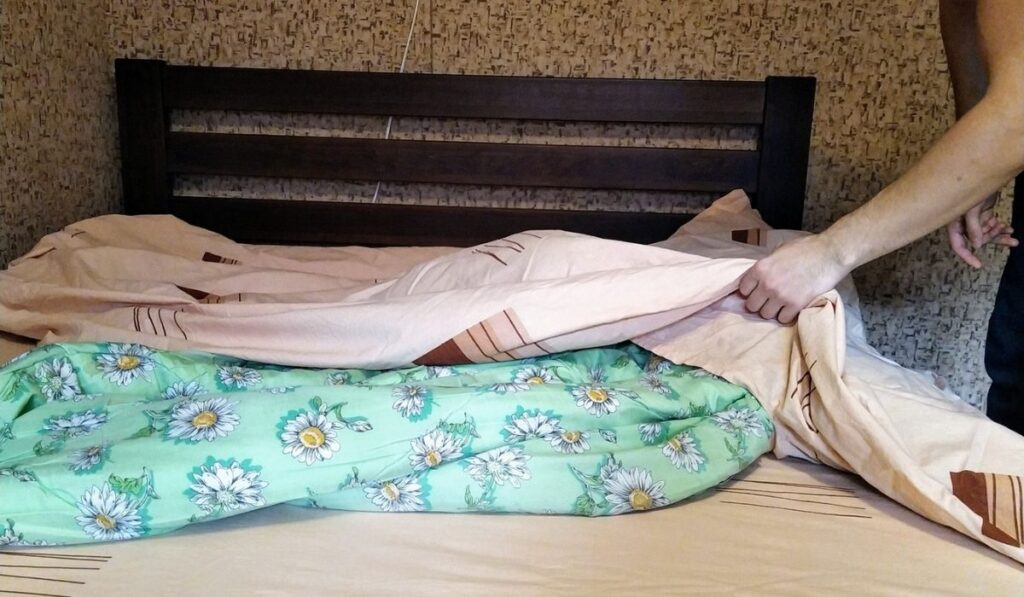Statistics show that each person typically spends at least a quarter of their day in bed. With this significant amount of time spent in bed, your bedding is not something to take lightly. But when it comes to bedding, the options can seem endless — and a bit confusing. For example, what’s a duvet cover? And what goes inside it?
Duvet covers are normally filled with a duvet made with either natural materials — like goose feathers (down), silk, flannel, or cotton — or synthetic ones, like microfiber, hollow fiber, etc. In addition to providing comfort, these materials also help regulate body temperature.
Many different materials are used to fill duvets (and, in turn, duvet covers), each with its benefits. However, natural materials are generally known to regulate temperature better and be more breathable. Let’s look at this information in more detail.
What Is a Duvet Cover?

A Duvet cover can be described as a sizeable pocket-like piece of fabric that you put your duvet in and can close with zippers or buttons, just like a pillowcase for a pillow. The duvet cover protects your duvet from getting dirty or stained.
Any dirt or oil that makes it to your bed will only affect the duvet cover, which can be quickly removed and cleaned.
In addition, changing your duvet cover also enables you to change your bedding style and look conveniently. This way, you can save money while beautifying your bedroom.
What Do You Put Inside a Duvet Cover?
Duvet covers are typically filled with duvets made up of comfortable and breathable materials like goose down to aid your sleeping experience. You can also call it the duvet insert since you need to insert it into its cover.
What Is a Duvet?
A duvet can be defined as the top layer of bedding that looks decorative and provides warmth and comfort.
It’s kind of like a flat bag made of fabric that is filled with soft materials like down or hollow fiber. The fill power is the determinant of the weight as well as the warmth of a duvet.
The duvet is the insert put inside the duvet cover, which prevents it from getting dirty.
What Are Duvet Covers Made Of?
There are a plethora of materials used to make duvet covers. Some of these materials include:
- Silk: This is an example of natural filling material and one of the most expensive duvet cover materials. This is because it’s extremely light, easy to breathe in, cool, and very comfortable.
In addition to these fantastic qualities, silk duvets also regulate body temperature better than most duvet stuffing materials. It’s important to note that caution should be taken when washing silk duvet covers; you should follow the washing instructions to avoid damage.
If you’re interested in a silk duvet cover, check out the Pothuiny Duvet Cover Set (on Amazon).
- Cotton: This is one of the most widely used fabrics for duvet covers; it’s light and very breathable. Cotton duvet covers, like this one from JELLYMONI (on Amazon), are also a good temperature regulator since they work efficiently in alternate weather conditions. Cotton duvet covers are easy to wash and last longer than most.
- Wool: Wool naturally has a unique ability to trap air, which is excellent for regulating temperature. Wool duvet covers also help remove moisture from the body, and they’re antibacterial. Although wool is not as light as silk or cotton, it is also very durable.
- Microfiber: This is a polyester-made synthetic material. It was designed to feel like a natural material even though it isn’t the same. This material is also soft and silky; however, it is not as fluffy as natural duvet covers.
If you’re looking for a microfiber cover, check out the Bedsure Duvet Cover (Amazon).
How to Use a Duvet Cover

As discussed earlier, the function of duvet covers is just like a pillowcase; however, it’s essential to know that stuffing a duvet cover is not quite as simple. Using duvet covers can be stressful if you don’t know the steps involved. These steps include:
- Spread Out the Duvet: The first thing to do is lay out the duvet on your bed surface. The duvet has to be uniformly spread on the bed such that the edges should align with the four corners of the bed.
- Turn The Duvet Inside Out: Duvet covers can be opened/closed by a zipper or a button. So the next thing you’ll want to do is open your duvet cover and turn it inside out.
- Place the Inside-Out Cover on the Duvet: Then, you place the cover on top of the duvet, making sure that the corners of the cover match those of the duvet. You should then find a way to tie or clip the corners together. Once this is accomplished, you can reach inside the duvet cover and grab the duvet from the inside of the corner (hold the two corners from the inside tightly the same way).
- Flip the Cover and Pull Down: Still holding the duvet tightly from inside the corner, flip the cover and shake it down a bit for the duvet cover to envelope the duvet, and then zip/button your duvet and tuck it into your bed.
Can You Put a Comforter Inside a Duvet Cover?
As long as the duvet cover matches the size of the comforter, you can certainly put a comforter inside a duvet cover. Duvets and comforters serve a very similar purpose.
Still, check the measurements before you get a duvet cover for your comforter; sometimes, the sizes don’t match up even if they’re called ‘King’ or ‘Queen.’
Can You Use a Duvet Cover By Itself?
Even though sleeping with the duvet cover might not be as warm or enjoyable as having a duvet or a comforter, you can still use it alone. The duvet cover would be light and make your bedroom look less elegant, but it’s still efficient for sleeping on warmer nights.
